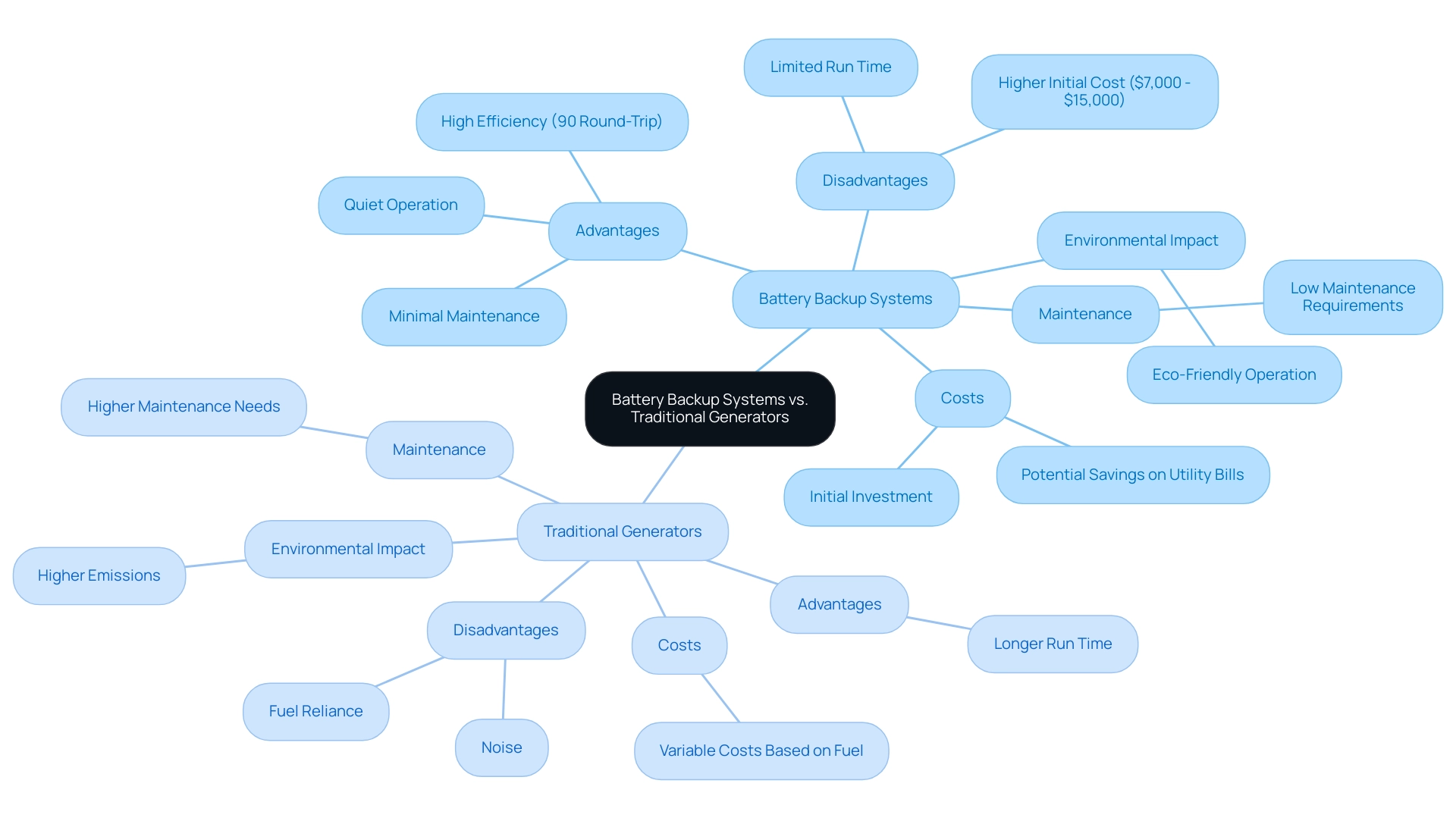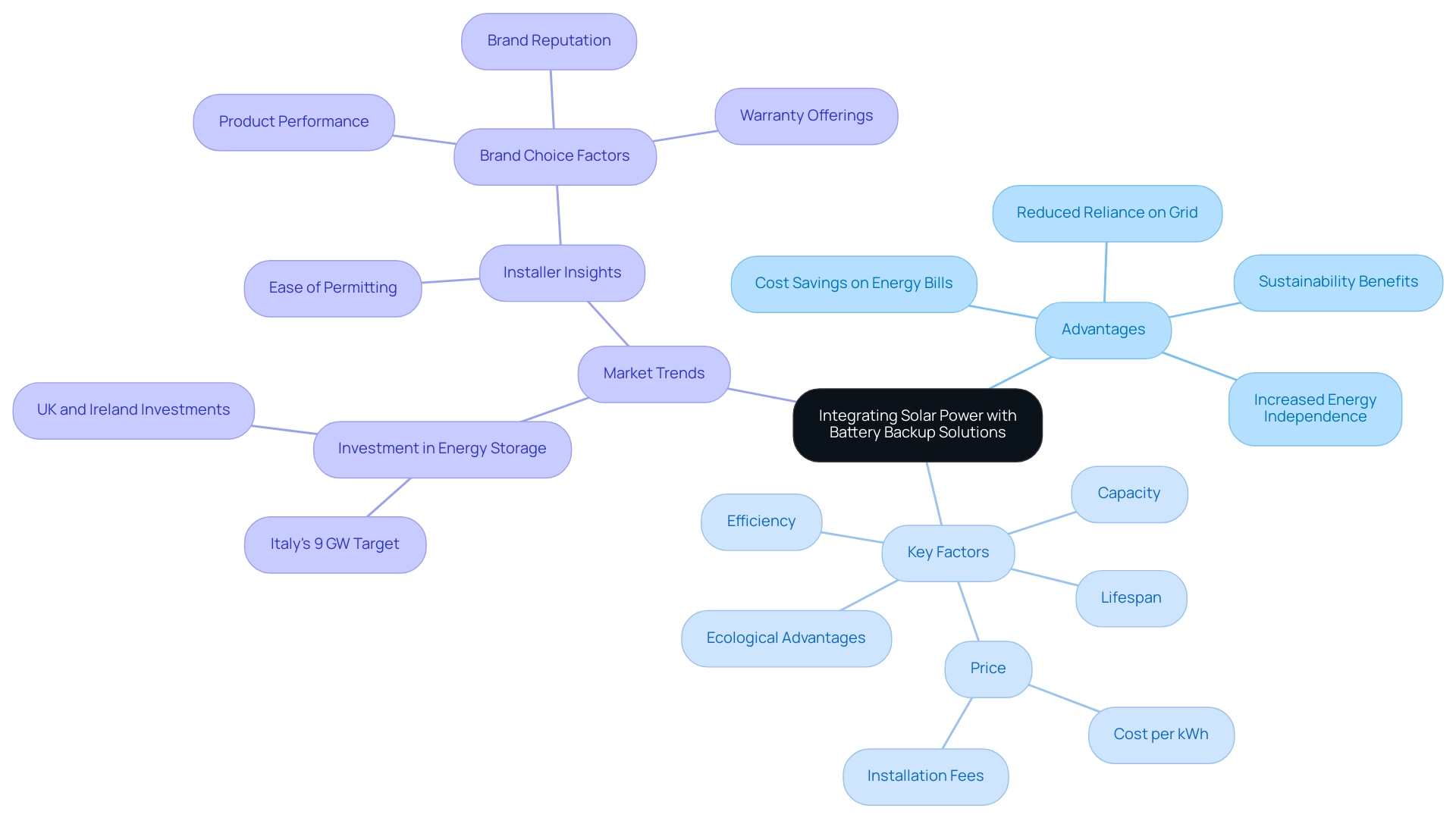Overview
Generators with battery backup are essential for homeowners seeking reliable power during outages, as they provide a dependable electricity source while integrating with renewable energy systems like solar panels. The article emphasizes the growing popularity of these systems due to their environmental benefits, low maintenance, and potential cost savings, making them a strategic choice for enhancing home energy resilience and independence.
Introduction
In an age where power outages can disrupt daily life, homeowners are increasingly turning to battery backup systems as a reliable solution for maintaining essential energy during unexpected blackouts. These innovative systems not only provide peace of mind but also offer a sustainable way to harness renewable energy, particularly when paired with solar panels.
As the world shifts toward greener technologies, understanding how these systems work and their benefits becomes crucial for those looking to enhance their home’s energy resilience. From evaluating different options to integrating them with solar power, this guide will illuminate the path toward a more energy-independent and secure future, ensuring that homes remain powered, even when the grid fails.
Introduction to Battery Backup Systems for Homeowners
Generator with battery backup solutions are essential tools that ensure your home remains powered during unexpected power outages. Imagine having a dependable source of electricity for your refrigerator, medical equipment, and essential lighting when the grid goes dark. These setups can be charged through the conventional power grid or utilize renewable sources, making them remarkably adaptable.
Homeowners are increasingly acknowledging the worth of these solutions for ensuring power resilience, particularly as trends indicate a rising incorporation of renewable resources and power storage technologies in our residences.
Solar panels function by transforming sunlight into electricity, which can be stored in energy storage units for future use. This integration not only maximizes power efficiency but also enables homeowners to depend less on the grid. In fact, the implementation of power reserve solutions among homeowners is anticipated to increase notably in 2024, indicating a transition towards more eco-friendly options.
Firms such as Powercore Electric, your leading battery backup service provider in Northern California, highlight the dependability and environmental benefits of these systems, assisting you in harnessing the power of sunlight effectively. Furthermore, government solar panel programs provide financial incentives and rebates that can significantly lower the initial investment costs for homeowners, making solar power more accessible. As Brian Melka, CEO of Rehlko, emphasizes, “Our company’s new name is derived from the six letters of Kohler and reflects the reliability, resolve, reinvention, and resilience that have been – and will remain – the hallmarks of this organization in addressing the ever-evolving distributed power needs of the marketplace.”
This dependability is essential for homeowners contemplating a generator with battery backup as a backup solution, as it aids in power independence and safety.
Furthermore, companies such as ORACLE rely on MarkWide Research for comprehensive market insights, emphasizing the increasing credibility and significance of these technologies in the sector. By grasping how backup solutions function alongside solar panels and the numerous advantages they offer, including government solar panel initiatives, you are making the initial move toward enhancing your home’s power autonomy and safety.
Comparing Battery Backup Systems and Traditional Generators
When it comes to maintaining your home energized during outages, both a generator with battery backup and conventional generators serve vital functions, each with its distinct benefits. Battery backups, like the Tesla Powerwall, which boasts an impressive 13.5 kilowatt-hours of storage capacity, operate quietly and are much more environmentally friendly. They require minimal maintenance, making them an appealing choice for homeowners who prefer hassle-free solutions.
Notably, the Tesla Powerwall also features a round-trip efficiency of around 90%, allowing for optimal resource usage. On the other hand, a generator with battery backup can run for longer durations, providing significant power during extended outages, though it comes with the trade-off of noise and reliance on fuel. Although power storage systems may have a higher initial expense, typically between $7,000 and $15,000, their long-lasting advantages—including decreased environmental effects and possible savings on utility bills—frequently surpass the primary expenditure.
Homeowners should also explore design and engineering services like those offered by GreenLancer, which can aid in selecting the ideal solution tailored to their specific needs. It’s essential to carefully consider energy requirements, budget, and personal preferences when deciding between these two options. As noted by the McKinsey Center for Future Mobility, electric vehicles (EVs) are set to increase from about 23 percent of global vehicle sales in 2025 to 45 percent by 2030, signifying a growing trend towards electric vehicles and sustainable living.
This makes a generator with battery backup an increasingly relevant choice for homeowners who are eco-conscious. Furthermore, a case study titled ‘Choosing Between a Generator Vs. Photovoltaic systems’ highlights the increasing appeal of energy storage solutions, offering important perspectives on their advantages and disadvantages—details that can significantly aid homeowners in making knowledgeable choices. The top solar energy storage options for effective energy retention not only offer dependability during outages but also improve the overall energy efficiency of solar setups.
Choosing the Right Battery Backup System for Your Home
Choosing the appropriate generator with battery backup for your home begins with comprehending the total wattage of the devices you intend to operate during a power failure. It’s crucial to choose a system, such as a generator with battery backup, that not only meets but ideally exceeds your needs. For example, a power storage capacity of 30 kWh at 48V LiFePo4 is a solid reference point for many homeowners.
Favored by homeowners, lithium-ion cells are distinguished by their durability, efficiency, and capacity to promote independence, making them an excellent option for a generator with battery backup solutions. As shared by user ‘iamrich’, having a stand-alone inverter for appliances like the water heater and laundry can alleviate concerns about energy supply during outages. Additionally, considering propane appliances for your kitchen and laundry can reduce upfront costs while ensuring reliability, especially on cloudy days.
When choosing your power source, consider key specifications like:
- Cycle life
- Depth of discharge
- Warranty terms
These factors impact both performance and economic benefits. It’s also beneficial to refer to user manuals and detailed guides on energy systems and power storage options, which can offer specific suggestions and optimal methods for installation and usage. Keep in mind that installation requirements can vary significantly, so it’s wise to consult with professionals to ensure your setup is installed safely and correctly.
Don’t forget to check for warranties and support services; these can provide peace of mind and protect your investment in this essential technology. As you explore your choices, keep in mind that a properly selected generator with battery backup can enhance your home’s durability and sustainability, enabling you to effectively utilize sunlight and enjoy the advantages of a dependable power source.
Integrating Solar Power with Battery Backup Solutions
Combining photovoltaic power with storage systems provides homeowners a robust and dependable power solution. By utilizing the sun’s power during the day, photovoltaic panels recharge the cells, enabling you to supply your home while storing surplus power for nighttime usage or in case of a disruption. This setup not only decreases your reliance on the grid but also contributes to significant savings on your energy bills.
Key factors to consider when choosing a photovoltaic energy storage system include:
- Capacity
- Efficiency
- Lifespan
- Price
- Ecological advantages of decreasing reliance on fossil fuels
For example, energy storage solutions can differ in cost from $1,000 to $2,000 per kWh of power storage, with installation fees often around $3,000 or more. Manufacturers like Bluetti and EcoFlow offer reliable options, with products such as the Bluetti EP900, known for its modular design and 9 kW output, providing various capacity choices.
As recent developments indicate, nations such as Italy, Britain, and Ireland are making significant strides in energy storage investments, with Italy aiming for at least 9 GW of storage capacity by the decade’s end. Such advancements emphasize the increasing significance of strong energy storage solutions in improving renewable energy integration. Furthermore, 85% of installers using NREL’s SolarAPP+ permitting software reported that it significantly eases the permitting process, highlighting practical benefits for homeowners considering renewable energy installations.
A survey among installers reveals that product performance, brand reputation, and warranty offerings are essential factors in their decisions, indicating that quality matters in this space. By adopting solar and storage solutions along with a generator with battery backup, homeowners not only improve their independence but also contribute significantly to promoting a sustainable future while ensuring safety against power interruptions and harsh weather conditions. To proceed, consider comparing options from various manufacturers and obtaining multiple quotes from installers to find the best solution tailored to your energy needs.
Maintenance and Troubleshooting for Battery Backup Systems
Routine upkeep of your generator with battery backup is essential for guaranteeing optimal performance, especially for environmentally-aware homeowners. Begin by examining the power source connections for any indications of corrosion and ensure it is clean and free from debris. Periodically testing the setup is a smart move to confirm everything is functioning correctly.
If you encounter issues, consulting the user manual for troubleshooting guidance is advisable. Common problems include:
- Insufficient charging
- The unit failing to activate during a power outage
If these issues persist, reaching out to a professional is a wise choice to prevent further complications.
Frank Delattre from Musashi Energy Solutions highlights the significance of sustainable practices in ensuring dependable power sources, stating that switching from conventional diesel generators to a generator with battery backup can greatly improve the reliability of backup solutions in residences. Additionally, it’s important to remember that lithium-ion cells typically lose about 20% of their capacity after just a year or two of regular use, underscoring the need for proactive maintenance. Remaining alert regarding these practices can significantly prolong the life of your generator with battery backup, ensuring your home remains powered when it matters most!
Furthermore, understanding the different types of batteries—such as lead-acid, lithium-ion, and flow batteries—along with their specifications can help you make informed choices that enhance performance and longevity. Financial advantages, like cost reductions over time and enhanced autonomy, also play a vital role in sustaining these structures. For more tailored solutions, including the best solar batteries and a generator with battery backup, feel free to contact Powercore Electric Inc., your friendly neighborhood expert in solar energy and EV charging stations.
Conclusion
Battery backup systems are becoming essential tools for homeowners aiming to maintain energy resilience during power outages. By integrating these systems with solar panels, homeowners can effectively harness renewable energy, reducing reliance on the grid and promoting sustainability. With options like the Tesla Powerwall providing impressive storage capabilities and efficiency, the choice between battery backups and traditional generators becomes clearer, especially for those prioritizing eco-friendliness and low maintenance.
Selecting the right battery backup system requires careful consideration of energy needs and specifications. Understanding the wattage of essential appliances and ensuring the chosen system exceeds those requirements will help in making an informed decision. Additionally, integrating solar power not only enhances energy independence but also offers significant long-term savings on energy bills, making it a smart investment for the future.
Regular maintenance and troubleshooting are crucial in ensuring these systems operate at peak performance. By staying proactive about inspections and understanding the various types of batteries available, homeowners can maximize the longevity and reliability of their backup systems. As the trend towards greener technologies continues to grow, embracing battery backup solutions alongside solar energy not only safeguards against outages but also contributes to a more sustainable and energy-efficient home.





